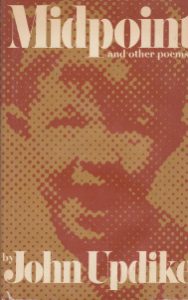 In a July 18 post on the blog Vertigo: Where literature and art intersect, with an emphasis on W.G. Sebald and literature with embedded photographs, a writer identified simply as “Terry” considers “‘Midpoint’: John Updike’s Pointillist Poem.”
In a July 18 post on the blog Vertigo: Where literature and art intersect, with an emphasis on W.G. Sebald and literature with embedded photographs, a writer identified simply as “Terry” considers “‘Midpoint’: John Updike’s Pointillist Poem.”
His argument: “The pictures [included in Canto II] speak for themselves. A cycle of growth, mating, and birth. The coarse dots, calligraphic and abstract, become faces with troubled expressions. Distance improves vision. Lost time sifts through these immutable screens.”
“Updike doesn’t seem to have made any attempt to make the photographs approximate any poetic form. There is no apparent rhythmic pattern to the way the photographs are placed on their five pages and the only organizing principle is chronology. The photographs themselves, which are reproduced as halftones, are purposely printed in such a way as to show the dots formed by the halftone screens. (Although, curiously, the halftone dots are strikingly less noticeable on three of the photographs—each of which is a head shot of Updike himself.) At first I wondered if his decision to emphasize the halftone dots might be related to the Pop Art of the time, especially Roy Lichtenstein. While it is certainly possible that Lichtenstein’s work created an awareness on Updike’s part of the underlying dots in halftone reproductions, Updike’s writing is not at all aligned with the goals of Pop Art. Rather, we should take Updike’s word for it that he sees the halftone patterns as a visual symbol of lost time and as a metaphor for distance. A halftone image—like life itself—is easier to see from afar.
Terry concludes with a final argument followed by an excerpt from Midpoint: “The poet strives to conclude, but his aesthetic of dots prevents him. His heroes are catalogued. World politics: a long view. Intelligent hedonistic advice. Chilmark Pond in August. He appears to accept, reluctantly, his own advice.”
Reality transcends itself within;
Atomically, all writers must begin.
The Truth arrives as if by telegraph:
One dot; two dots; a silence; then a laugh.
